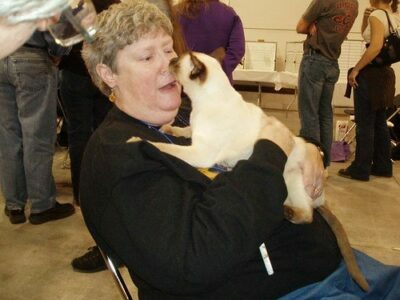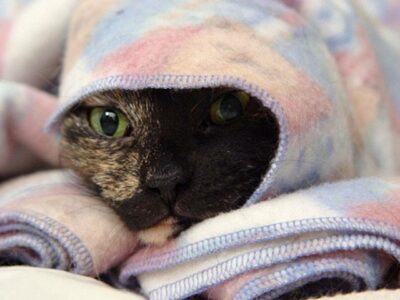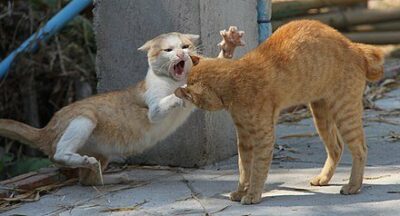Hello, two-legged readers! This is Lucinda the literate cat. I have noticed what seems to be an almost universal problem with you two-leggeds. When it comes to understanding a cat’s language, you can’t seem to translate it.
Therefore, in this post, I will try to give you a basic language lesson. I may have to write two or three posts on this subject, as our language can’t be explained easily in one short tutorial.
The first topic I want to discuss comes as a response to a misunderstanding I see all the time. I hear two-leggeds say that cats are standoffish, unfriendly, and don’t give love to any two-leggeds.
Don’t Compare Us To Dogs
This assessment seems very unfair. We act like cats, not like dogs, and you can’t compare us. As you two-leggeds say, it’s like comparing apples and oranges. A dog will flatter and fawn over a two-legged, but a cat doesn’t do that.
You probably don’t realize that in many ways we cats act more like people, when it comes to making friends. We behave just like you do. We like to get to know a two-legged first. We learn a bit about what kind of personality and habits you have.

Once we get to know you, then we will decide if we want to accept you as a friend. Once friendship becomes established, if we have a good relationship, that friendship can deepen into love.
We normally choose one special two-legged to bond with closely, Once we decide we love you, our love becomes unconditional. Unlike you, we don’t place qualifications on our affections — “I will love you as long as you do such-and-such.” Not our way — Once we love, it takes a great deal for that feeling to subside.
Giving Unconditional Love
Dogs love unconditionally, too, and in that respect, we act in the same way. You must mistreat us severely over a long period of time to destroy our love completely.
A dog whose owner mistreats him will cower and fawn and try to get back into favor with his master, even though the master beats him.
Therein lies the difference. We cats do not have masters. Partners, yes, but no one becomes master of the cat. We have too much independence. If our two-legged mistreats us, we will run away and hide. If the mistreatment becomes too severe, we may escape and seek a new home.

Don’t Destroy Our Trust
However, we do not give up on our love easily. What you do when you mistreat us amounts to slowly destroying our trust. If the trust erodes away and we have nothing left but fear, we bury that love deep inside.
We may refuse to believe our own poor judgment of this two-legged who betrays our trust and love. “I loved this two-legged because of some kindness he showed when I was needy, and I can’t believe the kindness has completely departed from this being.
” Even though I now feel fearful, deep down, I hope that things will change.”
Develop Your Friendship
If you want your cat to love you, you must first learn to develop a friendship. Talk to your cat; play with him. Don’t be afraid to show that you love him. Give him good food and a comfortable place to sleep.
Keep his litter box clean. After all, if you had to use a box like we do, would you want to stand in it if it didn’t get cleaned regularly?
As to how we talk to you, we express a lot of our thoughts and feelings through our bodies, and not through spoken language, as you two-leggeds do. We understand that you respond better to spoken language, and that is why we meow. We only do so for kittens or for two-leggeds.
However, one noise we cats make to each other is a yowl. We make this sound as a signal of aggression. Be prepared — the fight may commence at any time. No, we do not yowl at you two-leggeds.
When we meow at you, we want your attention, and we want to communicate something to you. Once you respond to the meow, if you observe well, you can perhaps figure out what we want to tell you.

Learn To Read Body Messages
Don’t ignore our request — use it as a signal that we want to make you understand something. Look at our body, and see if you can read its message.
We use different parts of our bodies to express different messages, so let’s start with the tail. Our tail tells a great deal about what we think.

I’ll give you some tail translations. Read this quote, as it speaks truth: “His tail is a mirror of his mind.” That quote comes from Walter Chandoha, who must understand tail language quite well.
Though our cat’s tail talk can have some unique dialects, we cats still share a common language. For example, if we hold our tail high, consider it a greeting that indicates alertness and that you have our attention.
If your cat’s tail waves gently, raised to about a 40-degree angle as he strolls along, you can consider him quite relaxed. If he smells something that needs further investigation, the tail will twitch, indicating he has a question about that scent.
Watch him if he sees a mouse. He increases his speed to a gallop, and the tail flattens and flows behind him. In such a position, it can act as a balancing tool, should he need extra stability while running.
Have you ever seen your cat flick his tail at something? My CCL (Cantankerous Cat Lady) compares such tail-action to the saying you two-leggeds have when disgusted with something: “Up yours.” Rude, but the cat’s tail-flick expresses a similar opinion.
How We Can Sometimes Escape Danger
What if your cat has ended up in a situation that could result in unpleasantness? The cat can fluff his tail to make himself look larger, allowing him to escape the situation.
Of course, when the tail fluffs out, the rest of the cat’s fur can do so as well, enhancing the idea that his size has just increased. CCL gives a good example in a story about Loose Cat, her black cat from Kodiak.
CCL tells about the time she had to take her two cats to stay in a motel for a night due to a flood. Loose Cat did not like confinement to the motel room, so when CCL opened the door to bring in luggage, Loose Cat escaped and raced down the long sidewalk in front of the motel, CCL close behind.
Loose Cat came to the corner of the building, and when he started around it, he saw a big German shepherd dog dozing there. When the cat saw the dog, he jumped up in the air about three feet, and when he came down, he was three sizes larger than when he went up.
The dog, taking one look at this frightful-looking creature, took off across the lawn at a dead run, never looking back, and soon disappearing from view.
Other Tail Messages

If your cat’s tail lashes slowly and deliberately, you’d best back off, as that tail provides a sign that the cat is seriously annoyed. Look to see how violently the tail lashes, as that indicates exactly how mad he’s become.
When hunting and slinking close to the ground, only the tip of the tail lashes. He can release some growing excitement in this way, allowing him to reach an optimum position for a final pounce.
Cats can greet other cats or you when you approach each other by raising the tail politely in greeting. It’s like you two-leggeds do, when you say, “Hello, how are you?” You don’t expect a long speech from the other; it is simply a polite acknowledgment of the newcomer.
If your cat wants to be left alone, he may tuck his tail in closely, and he’ll also tuck his paws in. Just give him space until he approaches you requesting attention. If he is edgy or uncertain, his tail may twitch nervously.
Watch that tail and learn to read it. The tail will tell you quite a bit about what goes on in kitty’s head.
In my next post, I will explain the meanings attached to other parts of the body. In the meantime, work on reading the tail messages you see. Learn to read the tail to translate some of the messages he sends.
If you have any questions or comments about anything in this post, please send your questions in the comments section below. CCL and I appreciate it when you do.
Reference used for this post:



Lucinda, you and that two-legged lady are a world of interesting information. Thank you.
Carole, thanks for your comment. I will pass it on to Lucinda, as I’m sure she will appreciate it. There will be another tutorial from Lucinda next week about communication messages from other parts of kitty’s body. I hope Gracie is helping you apply all this new knowledge by observing her behavior.